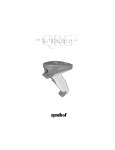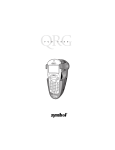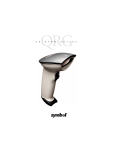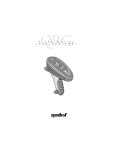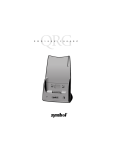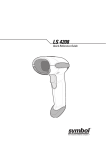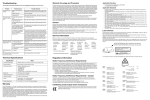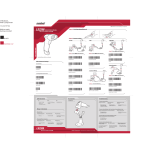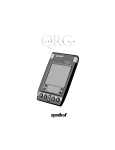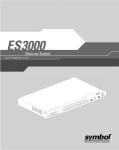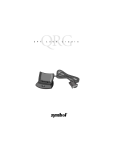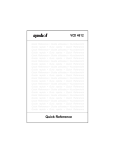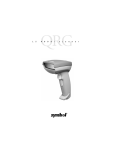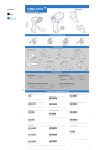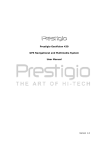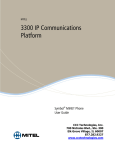Download Quick Start Guide - Barcode Datalink
Transcript
P
4 7 0 /
3 7 0
R F
S c a n n e r
P
4 7 0 /
3 7 0
R F
S c a n n e r
© 1997-2002 SYMBOL TECHNOLOGIES, INC. All rights reserved.
Symbol reserves the right to make changes to any product to improve reliability,
function, or design.
Symbol does not assume any product liability arising out of, or in connection with, the
application or use of any product, circuit, or application described herein.
No license is granted, either expressly or by implication, estoppel, or otherwise under
any patent right or patent, covering or relating to any combination, system,
apparatus, machine, material, method, or process in which Symbol products might
be used. An implied license exists only for equipment, circuits, and subsystems
contained in Symbol products.
Symbol and the Symbol logo are registered trademarks of Symbol Technologies, Inc.
Other product names mentioned in this manual may be trademarks or registered
trademarks of their respective companies and are hereby acknowledged.
Symbol Technologies, Inc.
One Symbol Plaza
Holtsville, N.Y. 11742-1300
http://www.symbol.com
Patents
This product is covered by one or more of the following U.S. and foreign Patents:
U.S. Patent No. 4,593,186; 4,603,262; 4,607,156; 4,652,750; 4,673,805; 4,736,095;
4,758,717; 4,760,248; 4,806,742; 4,816,660; 4,845,350; 4,896,026; 4,897,532; 4,923,281;
4,933,538; 4,992,717; 5,015,833; 5,017,765; 5,021,641; 5,029,183; 5,047,617; 5,103,461;
5,113,445; 5,130,520; 5,140,144; 5,142,550; 5,149,950; 5,157,687; 5,168,148; 5,168,149;
5,180,904; 5,216,232; 5,229,591; 5,230,088; 5,235,167; 5,243,655; 5,247,162; 5,250,791;
5,250,792; 5,260,553; 5,262,627; 5,262,628; 5,266,787; 5,278,398; 5,280,162; 5,280,163;
5,280,164; 5,280,498; 5,304,786; 5,304,788; 5,306,900; 5,324,924; 5,337,361; 5,367,151;
5,373,148; 5,378,882; 5,396,053; 5,396,055; 5,399,846; 5,408,081; 5,410,139; 5,410,140;
5,412,198; 5,418,812; 5,420,411; 5,436,440; 5,444,231; 5,449,891; 5,449,893; 5,468,949;
5,471,042; 5,478,998; 5,479,000; 5,479,002; 5,479,441; 5,504,322; 5,519,577; 5,528,621;
5,532,469; 5,543,610; 5,545,889; 5,552,592; 5,557,093; 5,578,810; 5,581,070; 5,589,679;
5,589,680; 5,608,202; 5,612,531; 5,619,028; 5,627,359; 5,637,852; 5,664,229; 5,668,803;
5,675,139; 5,693,929; 5,698,835; 5,705,800; 5,714,746; 5,723,851; 5,734,152; 5,734,153;
5,742,043; 5,745,794; 5,754,587; 5,762,516; 5,763,863; 5,767,500; 5,789,728; 5,789,731;
5,808,287; 5,811,785; 5,811,787; 5,815,811; 5,821,519; 5,821,520; 5,823,812; 5,828,050;
5,848,064; 5,850,078; 5,861,615; 5,874,720; 5,875,415; 5,900,617; 5,902,989; 5,907,146;
5,912,450; 5,914,478; 5,917,173; 5,920,059; 5,923,025; 5,929,420; 5,945,658; 5,945,659;
5,946,194; 5,959,285; 6,002,918; 6,021,947; 6,029,894; 6,031,830; 6,036,098; 6,047,892;
6,050,491; 6,053,413; 6,056,200; 6,065,678; 6,067,297; 6,082,621; 6,084,528; 6,088,482;
6,092,725; 6,101,483; 6,102,293; 6,104,620; 6,114,712; 6,115,678; 6,119,944; 6,123,265;
6,131,814; 6,138,180; 6,142,379; 6,172,478; 6,176,428; 6,178,426; 6,186,400; 6,188,681;
6,209,788; 6,209,789; 6,216,951; 6,220,514; 6,243,447; 6,244,513; 6,247,647; 6,308,061;
6,250,551; 6,295,031; 6,308,061; 6,308,892; 6,321,990; 6,328,213; 6,330,244; 6,336,587;
6,340,114; 6,340,115; 6,340,119; 6,348,773; 6,380,949; 6,394,355; D305,885; D341,584;
D344,501; D359,483; D362,453; D363,700; D363,918; D370,478; D383,124; D391,250;
D405,077; D406,581; D414,171; D414,172; D418,500; D419,548; D423,468; D424,035;
D430,158; D430,159; D431,562; D436,104.
Invention No. 55,358; 62,539; 69,060; 69,187, NI-068564 (Taiwan); No. 1,601,796; 1,907,875;
1,955,269 (Japan); European Patent 367,299; 414,281; 367,300; 367,298; UK 2,072,832; France
81/03938; Italy 1,138,713
rev. 06/02
Q u i c k
R e f e r e n c e
Introduction
The P470/370 cordless RF scanners bring new flexibility and
economy to data capture and data management in both industrial
and retail operations. The scanner communicates with your host
computer through radio transmission instead of through a cable.
With the RF scanner, you are free to scan and transmit without a
physical cable, from as far away as 100 feet (30.5 meters) even
without a direct line of sight. This lets you take the scanner to
where the work is, whether on the loading dock, the plant floor, the
warehouse, or the POS checkout area. There are several versions
available:
•
P470: cordless retail scanner
•
P370: cordless industrial scanner
•
P370 ALR: cordless industrial ALR scanner.
Refer to PL 370/470 RF Cradle Quick Reference Guide (p/n 7238494-xx) for information on setting up the PL 370/470 RF cradle.
To quickly get you started with your new scanner:
1. Charge the scanner in the cradle (see page 2).
2. Power up the scanner (see page 2).
3. Follow the Quick Startup Instructions (see page 6).
4. Use the test bar codes to ensure the scanner is working
properly (see page 7).
1
P
4 7 0 /
3 7 0
R F
S c a n n e r
Charging the Scanner in the Cradle
To charge the scanner, insert the
scanner into the cradle so the nose
of the scanner and tip of the handle
seat into the receptacles. The
scanner displays “UNIT CRADLED”
when properly inserted in the cradle.
The battery charges automatically. A
full charge of a depleted battery
takes approximately 3-1/2 hours.
The charge status indicator light on
the back of the cradle blinks then
becomes solid when the battery is
fully charged.
Charge Status
Indicator Light
Powering Up the Scanner
To turn the scanner on, press the “Enter” key or pull the trigger.
The scanner is brought out of sleep mode and into scanning
mode.
Scanning
Consult the P470/P370 RF Scanners Product Reference Guide
(p/n 72-38495-xx) for programming instructions. If you need
assistance, contact your local supplier or the Symbol Support
Center.
1. Ensure the battery is
charged.
2. Make sure the bar code is
in the correct scanning
range. Aim and press the
trigger. When the scanner
has read the symbol:
-
You hear a beep.
The LED above the display turns green.
2
Q u i c k
-
R e f e r e n c e
The red laser turns off.
Hold at an angle
Do not hold the scanner directly perpendicular to the bar code.
Laser light reflecting directly back into the scanner from the bar
code is known as specular reflection. This strong light can
temporarily “blind” the scanner and make decoding difficult. The
area where specular reflection occurs is known as a “dead zone”.
You can tilt the scanner up to 65° forward or backward and achieve
a successful decode. Simple practice quickly shows what
tolerances to work within.
1. Successful
Scanning
2. Possible Specular
Reflection
3. Successful
Scanning
65°
65°
Shaded area represents
dead zone (+-2°)
Scan
Beam
Scan
Beam
Bar Code
Bar Code
3
Bar Code
P
4 7 0 /
3 7 0
R F
S c a n n e r
Scan the entire symbol
•
•
•
The scan beam must cross every bar and space on the symbol (as in the left bar code below).
The larger the symbol, the farther away you should hold the
scanner.
Hold the scanner closer for symbols with bars that are close
together.
Right
Wrong
4
Q u i c k
R e f e r e n c e
Changing the Battery
Once a battery is fully charged, it will generally last up to 10 hours
without being returned to the cradle. By returning it to the cradle
during the day, you extend this time.
Removing the Battery
1. Slide the battery release latch down using center indent and
remove the battery compartment cover.
2. Slide the battery toward the bottom of the scanner and then
pull the bottom of the battery back and out of the scanner.
Battery
Compartment
Cover
Battery
Release
Latch
Replacing the Battery
1. Place the top portion of the battery (curved side up, contacts
toward top) into the scanner and then slide it up the handle.
2. Replace the battery compartment cover.
3. Slide the release latch up to secure the cover in place.
5
P
4 7 0 /
3 7 0
R F
S c a n n e r
Quick Startup Instructions
Below is an index of Quick Startup Instructions to help get you started quickly. The
index is listed in a step by step order beginning with step 1, Setting up the System.
This index references the pages from the P470/P370 RF Scanners Product
Reference Guide (p/n 72-38495-xx). The Product Reference Guide is included on the
CD shipped with your scanner. It is also available on the Symbol Web Site http://
www.symbol.com/manuals, or can be purchased in hard copy by contacting Symbol
Technologies.
Mandatory steps are designated by an asterisk (*). If an item has multiple pages
referenced, the most important reference is in bold.
PRG Page
1. Setting Up the System
•
Connecting the cradle to a host *
2-1
- RS-232 connection
2-2
- Synapse connection (keyboard wedge, USB, etc.)
2-3
•
Charging the battery *
1-3, 2-8
•
Pairing the scanner with the cradle *
2-6
- RF channel
3-8, 5-13, C-1
- Coexisting in Spectrum24 environments
2-7
2. Using the Default Applications
•
Overview of Scan and Transmit application*
3-2
•
Keypad operation
3-2, 3-3, 3-22
•
Eliminating repetitive scanning
3-4
•
Selecting the host communication protocol
3-2, 3-8, 5-8
- RS-232 baud rate
5-81
3. Programming an Advanced Data Formatting Rule Using 123Scan
3-17
4. Troubleshooting Problems
•
Troubleshooting table
3-24
•
Communication errors
3-5, D-2
•
Beeper indications and default application error codes
4-7
•
Cradle LED indications
4-3
6
Q u i c k
R e f e r e n c e
Test Symbols
Code 128
EAN-8
13 Mil UPC
Code 39
7
P
4 7 0 /
3 7 0
R F
S c a n n e r
Ergonomic Recommendations
Caution: In order to avoid or minimize the potential risk of ergonomic injury follow the
recommendations below. Consult with your local Health & Safety Manager to ensure
that you are adhering to your company’s safety programs to prevent employee injury.
• Reduce or eliminate repetitive motion
• Maintain a natural position
• Reduce or eliminate excessive force
• Keep objects that are used frequently within easy reach
• Perform tasks at correct heights
• Reduce or eliminate vibration
• Reduce or eliminate direct pressure
• Provide adjustable workstations
• Provide adequate clearance
• Provide a suitable working environment
• Improve work procedures.
Regulatory Information
All Symbol devices are designed to be compliant with rules and regulations in
locations they are sold and will be labeled as required.
Any changes or modifications to Symbol Technologies equipment, not expressly
approved by Symbol Technologies, could void the user's authority to operate the
equipment.
Tested to comply
with FCC Standards
Radio Frequency Interference
Requirements
FOR HOME OR OFFICE USE
Note: This equipment has been tested and found to comply with
the limits for a Class B digital device, pursuant to Part 15 of the FCC rules. These
limits are designed to provide reasonable protection against harmful interference in a
residential installation. This equipment generates, uses, and can radiate radio
frequency energy and, if not installed and used in accordance with the instructions,
may cause harmful interference to radio communications. However there is no
guarantee that interference will not occur in a particular installation. If this equipment
does cause harmful interference to radio or television reception, which can be
determined by turning the equipment off and on, the user is encouraged to try to
correct the interference by one or more of the following measures:
• Reorient or relocate the receiving antenna
• Increase the separation between the equipment and receiver
• Connect the equipment into an outlet on a circuit different from that to which the
receiver is connected
• Consult the dealer or an experienced radio/TV technician for help.
8
Q u i c k
R e f e r e n c e
Radio Frequency Interference Requirements - Canada
This device complies with RSS 210 of Industry & Science Canada. Operation is
subject to the following two conditions: (1) this device may not cause harmful
interference and (2) this device must accept any interference received, including
interference that may cause undesired operation.
This Class B digital apparatus complies with Canadian ICES-003.
Cet appareil numérique de la classe B est conforme à la norme NMB-003 du Canada.
Marking and European Economic Area (EEA)
Statement of Compliance
Symbol Technologies, Inc., hereby, declares that this device is in
compliance with the essential requirements and other relevant provisions of
Directives 1999/5/EC, 89/336/EEC and 73/23/EEC. Declaration of Conformities may
be obtained from http://www2.symbol.com/doc/
Laser Devices
Symbol products using lasers comply with US 21CFR1040.10, and
IEC825-1:1993, EN60825-1:1994+A11:1996. The laser classification is
marked on one of the labels on the product.
Class 1 Laser devices are not considered to be hazardous when used for their
intended purpose. The following statement is required to comply with US and
international regulations:
Caution: Use of controls, adjustments or performance of procedures other than those
specified herein may result in hazardous laser light exposure.
Class 2 laser scanners use a low power, visible light diode. As with any very bright
light source, such as the sun, the user should avoid staring directly into the light
beam. Momentary exposure to a Class 2 laser is not known to be harmful.
9
P
4 7 0 /
3 7 0
R F
Scanner Labeling
C A U T I O N
LASER LIGHT-DO NOT STARE INTO BEAM
630-680 nM LASER 1.0 mW MAX OUTPUT
CLASS II LASER PRODUCT
LASERLICHT - NICHT IN DEN STRAHL BLICKEN, LASER KLASSE 2
LUMIERE LASER-NE PAS REGARDER DANS LE FAISCEAU
APPARIEL A LASER DE CLASSE 2. CAUTION-LASER LIGHT DO NOT
STARE INTO BEAM. IEC CLASS 2 LASER PRODUCT 630-680mW LASER
10
S c a n n e r
Q u i c k
R e f e r e n c e
In accordance with Clause 5, IEC 825 and EN60825, the following information is
provided to the user:
ENGLISH
CLASS 1
CLASS 2
HEBREW
CLASS 1 LASER PRODUCT
LASER LIGHT
DO NOT STARE INTO BEAM
CLASS 2 LASER PRODUCT
DANISH / DANSK
KLASSE 1
KLASSE 1 LASERPRODUKT
KLASSE 2
LASERLYF
SE IKKE IND I STRÅLEN
KLASSE 2 LASERPRODUKT
ITALIAN / ITALIANO
CLASSE 1
PRODOTTO AL LASER DI CLASSE 1
CLASSE 2
LUCE LASER
NON FISSARE IL RAGGIOPRODOTTO
AL LASER DI CLASSE 2
DUTCH / NEDERLANDS
KLASSE 1
KLASSE-1 LASERPRODUKT
KLASSE 2
LASERLICHT
NIET IN STRAAL STAREN
KLASSE-2 LASERPRODUKT
NORWEGIAN / NORSK
KLASSE 1
LASERPRODUKT, KLASSE 1
KLASSE 2
LASERLYS IKKE STIRR INN I LYSSTRÅLEN
LASERPRODUKT, KLASSE 2
FINNISH / SUOMI
LUOKKA 1
LUOKKA 1 LASERTUOTE
LUOKKA 2
LASERVALO
ÄLÄ TUIJOTA SÄDETTÄ
LUOKKA 2 LASERTUOTE
PORTUGUESE / PORTUGUÊS
CLASSE 1
PRODUTO LASER DA CLASSE 1
CLASSE 2
LUZ DE LASER NÃO FIXAR O RAIO LUMINOSO
PRODUTO LASER DA CLASSE 2
FRENCH / FRANÇAIS
CLASSE 1
PRODUIT LASER DE CLASSE 1
CLASSE 2
LUMIERE LASER
NE PAS REGARDER LE RAYON FIXEMENT
PRODUIT LASER DE CLASSE 2
SPANISH / ESPAÑOL
CLASE 1
PRODUCTO LASER DE LA CLASE 1
CLASE 2
LUZ LASER
NO MIRE FIJAMENTE EL HAZ
PRODUCTO LASER DE LA CLASE 2
GERMAN / DEUTCH
KLASSE 1
LASERPRODUKT DER KLASSE 1
KLASSE 2
LASERSTRAHLEN
NICHT DIREKT IN DEN LASERSTRAHL SCHAUEN
LASERPRODUKT DER KLASSE 2
SWEDISH / SVENSKA
KLASS 1
LASERPRODUKT KLASS 1
KLASS 2
LASERLJUS STIRRA INTE MOT STRÅLEN
LASERPRODUKT KLASS 2
RF Devices
Symbol’s RF products are designed to be compliant with the rules and regulations in
the locations into which they are sold and will be labeled as required. The majority of
Symbol’s RF devices are type approved and do not require the user to obtain license
or authorization before using the equipment. Any changes or modifications to Symbol
Technologies equipment not expressly approved by Symbol Technologies could void
the user’s authority to operate the equipment.
The Spectrum24 equipment is intended for use throughout the European Economic
Area, but its authorization for use in France is restricted as follows:
• PAN European Frequency Range: 2.400 - 2.4835 GHz, identified by -EU suffix to the model number found on the product label
• France - Restrict Frequency Range for use in France: 2.4465 - 2.4835 GHz,
identified on [Product mmmm] by the -FR suffix to the model number found on
the product label
11
P
4 7 0 /
3 7 0
R F
S c a n n e r
• Belgium - Operation in an out of doors environment in Belgium must be
restricted to 2.460 - 2.4835 GHz band
• Italy - Operation in Italy requires a user license
• Mexico - Restrict Frequency Range for use in Mexico: 2.450 - 2.4835 GHz
• Chile - Restricted Power Output for use in Chile: 50 mW
Caution:
Handheld Devices: FCC RF Exposure Guidelines
To satisfy FCC RF exposure compliance requirements for a mobile transmitting device, this device should be used in hand-held, hand-operated configurations only. The device and its antenna should generally maintain a
separation distance of 20 cm or more from a person’s body; except for the
hands and wrists because of higher exposure limit for extremities. This device is designed to be used in a person’s hands and its operating configurations, generally do not support normal transmissions while it is carried in
pockets or holsters next to a person’s body.
Caution:
Remote and Standalone Antenna Configurations: FCC
RF Exposure Guidelines
To comply with FCC RF exposure requirements, antennas that are mounted
externally at remote locations or operating near users at stand-alone desktop
of similar configurations must operate with a minimum separation distance
of 20 cm from all persons.
12
Q u i c k
R e f e r e n c e
Warranty
(A) Seller’s hardware Products are warranted against defects in workmanship and
materials for a period of twelve (12) months from the date of shipment, provided the
Product remains unmodified and is operated under normal and proper conditions.
Warranty provisions and durations on software, integrated installed systems, Product
modified or designed to meet specific customer specifications ("Custom Products"),
remanufactured products, and reconditioned or upgraded products, shall be as
provided in the applicable Product specification in effect at the time of purchase or in
the accompanying software license. (B) Products may be serviced or manufactured
with parts, components, or subassemblies that originate from returned products and
that have been tested as meeting applicable specifications for equivalent new
material and Products. The sole obligation of Seller for defective hardware Products
is limited to repair or replacement (at Seller’s option) on a "return to service depot"
basis with prior Seller authorization. Shipment to and from Seller will be at Seller’s
expense, unless no defect is found. No charge will be made to Buyer for replacement
parts for warranty repairs. Seller is not responsible for any damage to or loss of any
software programs, data or removable data storage media, or the restoration or
reinstallation of any software programs or data other than the software, if any,
installed by Seller during manufacture of the Product. The aforementioned provisions
do not extend the original warranty period of any Product that had either been
repaired or replaced by Seller. (C) The above warranty provisions shall not apply to
any Product (i) which has been repaired, tampered with, altered or modified, except
by Seller’s authorized service personnel; (ii) in which the defects or damage to the
Product result from normal wear and tear, misuse, negligence, improper storage,
water or other liquids, battery leakage or failure to perform operator handling and
scheduled maintenance instructions supplied by Seller; (iii) which has been subjected
to unusual physical or electrical stress, abuse, or accident, or forces or exposure
beyond normal use within the specified operational and environmental parameters
set forth in the applicable Product specification; nor shall the above warranty
provisions apply to any expendable or consumable items, such as batteries, supplied
with the Product. EXCEPT FOR THE WARRANTY OF TITLE AND THE EXPRESS
WARRANTIES STATED ABOVE, SELLER DISCLAIMS ALL WARRANTIES ON
PRODUCTS FURNISHED HERUNDER INCLUDING ALL IMPLIED WARRANTIES
OF MERCHANTABLILTY AND FITNESS FOR A PARTICULAR USE. ANY IMPLIED
WARRANTIES THAT MAY BE IMPOSED BY LAW ARE LIMITED IN DURATION TO
THE LIMITED WARRANTY PERIOD. SOME STATES OR COUNTRIES DO NOT
ALLOW A LIMITATION ON HOW LONG AN IMPLIED WARRANTY LASTS OR THE
EXCLUSION OR LIMITATION OF INCIDENTAL OR CONSEQUENTIAL DAMAGES
FOR CONSUMER PRODUCTS. IN SUCH STATES OR COUNTIRES, FOR SUCH
PRODUCTS, SOME EXCLUSIONS OR LIMITATIONS OF THIS LIMITED
WARRANTY MAY NOT APPLY. The stated express warranties are in lieu of all
obligations or liabilities on the part of Seller for damages, including but not limited to,
special, indirect or consequential damages arising out of or in connection with the use
or performance of the Product or service. Seller’s liability for damages to Buyer or
others resulting from the use of any Product or service furnished hereunder shall in
no way exceed the purchase price of said Product or the fair market value of said
service, except in instances of injury to persons or property.
13
Service Information
Before you use the unit, it must be configured to operate in your facility’s network and
run your applications.
If you have a problem running your unit or using your equipment, contact your facility’s
Technical or Systems Support. If there is a problem with the equipment, they will
contact the Symbol Support Center:
United States1
1-800-653-5350
1-631-738-2400
Canada
905-629-7226
United Kingdom
0800 328 2424
Asia/Pacific
+65-6796-9600
Australia
1-800-672-906
Austria/Österreich
1-505-5794-0
Denmark/Danmark
7020-1718
Finland/Suomi
9 5407 580
France
01-40-96-52-21
Germany/Deutchland
6074-49020
Italy/Italia
2-484441
Mexico/México
5-520-1835
Netherlands/Nederland
315-271700
Norway/Norge
+47 2232 4375
South Africa
11-8095311
Spain/España
91 324 40 00
Inside Spain
Sweden/Sverige
84452900
Latin America
Sales Support
1-800-347-0178 Inside US
+1-561-483-1275 Outside US
Europe/Mid-East
Distributor Operations
Contact local distributor or call
+44 118 945 7360
1
+34 91 324 40 00
Outside Spain
Customer support is available 24 hours a day, 7 days a week.
For the latest version of this guide go to:
http://www.symbol.com/manuals.
72-38493-01
Revision C — November 2002
Symbol Technologies, Inc. One Symbol Plaza Holtsville, NY 11742-1300
















